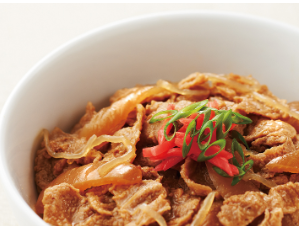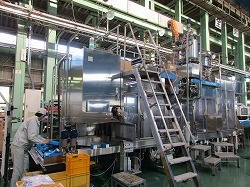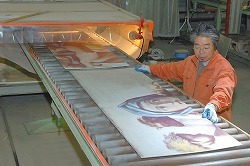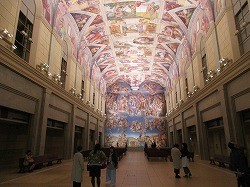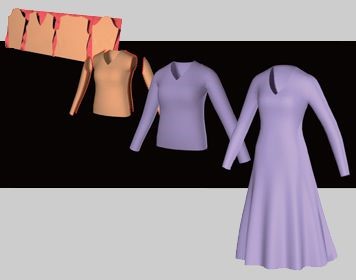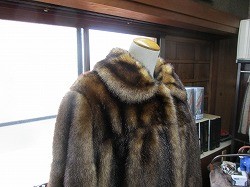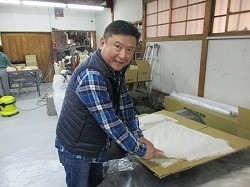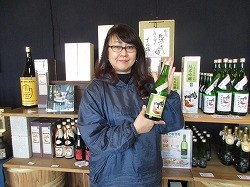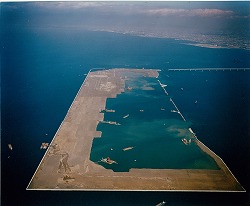Date : May 16 - 17, 2019
Notice: G20 Osaka Summit 2nd Press Tour (Osaka, Tokushima, Wakayama)
post date : 2019.05.10
[Overview]
<Theme: Kansai—A Pillar of the Japanese Economy >
- Osaka & Tokushima: Innovative Technology Contributing to the Solution of Global Issues
- Wakayama: The Global Fashion Industry Taking Interest in a Unique Technique
- The Challenge of Tokushima, Birthplace of LED
- Osaka, Making All Possible Preparations for the G20 Osaka Summit
On June 28 and 29, 2019, the G20 Summit will be held in Osaka. World leaders from advanced and emerging economies will meet to discuss how to achieve stable growth of the global economy, and topics including how to handle global issues such as the Sustainable Development Goals.
In the summit venue of Osaka, and throughout the Kansai region (including Tokushima), there are many companies with a global presence thanks to their ample creativity and unique techniques. Many of these companies have innovative technologies contributing to solutions for issues that the international community is cooperating to solve, such as environmental issues including climate change and conservation, and social issues such as aging societies.
This tour will go to Osaka, Tokushima, and Wakayama approximately one month before the summit, and visit companies with advanced technologies in fields such as sustainability. The tour will look at the power enabling Kansai to contribute to the future of global society, through innovative technologies and ideas in fields including food, fashion, and art.
[Tour Details]
<1. Innovative Technology Contributing to the Solution of Global Issues>
Fuji Oil Holdings Inc. (Osaka)
Contributing to the solution of food shortages with soy protein, which has a low environmental impact
As the global population grows, there are expected to be shortages of food (particularly animal protein) and water in the future. Soy protein has been receiving attention as a possible solution to this issue. Soybeans can be grown in many regions, from cold climates to tropical climates, and can be cultivated in large quantities with minimal fertilizer and water. The protein in soy has almost the same nutritional value as animal protein, and also has health benefits such as decreasing blood cholesterol levels.
Fuji Oil Holdings Inc. is the largest processed food oil company in Japan. Believing that plant products could solve food shortages, in particular protein shortages, the company has been involved in researching and developing products using soy protein and promoting the adoption of soy products since the 1960s. One of the company’s products is its “soy meat,” with a texture similar to meat, using heat and pressure to make defatted soy fibrous. Using their unique technology, Fuji Oil produces soy meat with different textures, such as chicken or beef, to create products with the same taste and appearance as actual meat. Using the Ultra Soy Separation process developed by Fuji Oil, they were the first to patent a process to separate soy into soy milk cream and low-fat soy milk, similar to how milk can be separated into cream and low-fat milk. Cheese made using low-fat soy milk melts nicely when heated, and can be used for dishes such as pizza. With increased awareness of sustainability, increased popularity of healthy eating, and diversification of foods due to population growth, there is growing demand for food products using soy protein.
The tour will visit the Fuji Science Innovation Center (SIC) which opened in Fuji Oil’s Hannan Business Operations Complex in 2016, and after a briefing on how the company is contributing to solving global food issues with soy protein products, will be able to film and photograph a variety of dishes made with all meat and dairy products replaced with soy products. (Photos and videos are only allowed within the SIC at the Hannan Business Operations Complex.)
(Pictures provided by Fuji Oil Holdings Inc.)
Shikoku Kakoki Co., Ltd. (Tokushima)
Enabling food products that meet society’s needs with the leading food filling and packaging technology in the world
Shikoku Kakoki Co., Ltd. makes machines to fill paper or plastic containers for food and beverage products. They produce a variety of filling machines for different food products, from beverages such as juice and alcohol, to yogurt and pudding, and even cup noodles. The company has a 70% share of the domestic market for filling machines that can create tetrahedron packages, such as for milk cartons, and export their filling machines to over 50 countries around the world. In 1973, Shikoku Kakoki was also the first company in Japan to develop a machine that could fill and seal cup noodle packages, making further development of the Japanese instant noodle industry possible. The company’s machines have become indispensable to the manufacturing and distribution of food products by companies in Japan and around the world. A unique characteristic of Shikoku Kakoki is that in addition to making food machinery, the company also develops packaging such as containers and lids, and makes food as well, tofu in particular. By using the knowhow developed from making food products in the manufacturing and development of filling machines and packaging, the company has developed creative technologies thanks to this positive feedback loop. With consumer’s food needs becoming more diversified, due to increasing numbers of senior citizens and single-person households, as well as a growing trend towards healthy living, and the importance of reduced environmental impact also growing, food products are continually evolving, with new types of packaging being developed. With the global trend to reduce plastic use, Shikoku Kakoki and Nippon Paper is developing a new paper container filling system to replace plastic bottles, with a cap that can be opened and closed. These new containers use approximately 70% less plastic than plastic bottles, for 250 milliliter containers.
The tour will hear an explanation about Shikoku Kakoki, which continues to develop original products in response to issues facing society, and visit their plant which produces filling machines and other products.
Otsuka Museum of Art (Tokushima)
Archiving and preserving cultural assets using advanced ceramic panel technology
Otsuka Ohmi Ceramics Co., Ltd. was the first company in the world to successfully develop thin, large ceramic panels without warping, and have used this ceramics technology for a one-of-a-kind business: replicating famous paintings to scale using ceramic panels (toban). The company is able to create nearly 20,000 colors with different glaze mixes, and ceramic is also durable and resistant to weathering. In addition to these “toban masterpieces,” in recent years the company has also been using 3D technology to replicate statues and earthenware pottery. Although the original pieces unavoidably deteriorate over time, ceramic has semi-permanent durability, so cultural assets can be passed on to the next generation without their appearance changing: The company has found a new method for archiving, preserving, and utilizing cultural assets.
The Otsuka Museum of Art (in Naruto, Tokushima) exhibits more than 1,000 toban masterpieces produced by Otsuka Ohmi Ceramics. Masterpieces from around the world, such as Leonardo da Vinci’s The Last Supper, have been faithfully reproduced, including not only the size and color, but also surface texture and brush strokes. The museum had 420,000 visitors in the 2018 fiscal year. Not only can visitors see masterpieces from around the world all in one place, which are just as impressive as the originals, unlike the originals it is possible to see these pieces close up, and even touch them, making the museum a place where children learn to love art and culture. Taking advantage of the weather resistant properties of ceramic panels, the museum was able to display Monet’s Water Lilies outside, fulfilling the wishes of the painter that it be seen under natural light. This ceramic panel technology allows new possibilities for art museums.
After receiving an explanation about how Otsuka Ohmi Ceramics’ ceramic panel technology has contributed to the preservation of cultural assets, the process to create toban masterpieces, and the unique features of the Otsuka Museum of Art, the tour will look at some of its most well-known exhibits, such as the painted ceiling of the Sistine Chapel.
(Left picture provided by Otsuka Ohmi Ceramics Co., Ltd.)
<2. The Global Fashion Industry Taking Interest in a Unique Technique from Wakayama>
Shima Seiki Mfg., Ltd. (Wakayama)
Sweeping the global fashion industry with knitting machines that produce seam-free knitwear
Shima Seiki Mfg., Ltd. (located in Wakayama City) is one of the top makers of knitting machines, with the top share of the global market for computerized flat knitting machines. From Uniqlo to Hermès and Prada, Shima Seiki’s Wholegarment knitting machines are used by the fashion industry worldwide. The founder and chairman of Shima Seiki is Mr. Masahiro Shima, 82 years old and still active as an inventor. At the age of 18, having invented elastic safety gloves which tighten around the wrist using elastic yarn, he founded the company in 1962. Starting with a fully automated glove knitting machine in 1964, Shima Seiki invented a series of “world-first” technologies. The Digital Stitch Control System the company developed in 1985 was praised by a specialist magazine in England, the birthplace of knitwear, as “The greatest invention of the century for knitting machines.” Ten years later, in 1995, Shima Seiki announced their Wholegarment knitting machines. This revolutionary technology, making it possible to automatically knit an entire knitwear garment without the need for sewing, had a major impact on the global fashion industry and was called “The Magic of the Orient.” Since the Wholegarment machines eliminate the need for post-processing such as cutting and sewing, they reduced the labor and time involved while also allowing for significant freedom of design. The lack of seams also means the garments produced are light and fit comfortably. The freedom of movement allowed by the lack of seams is beneficial not only for fashion, but also for sports and the medical industry, and the clothes astronauts wear while in space ship. Additionally, since Wholegarment machines make an entire garment at once, there is no loss of materials from cutting and sewing the material, making Wholegarment knitwear environmentally friendly by using the minimum amount of resources.
After seeing a demonstration of knitwear being producing by a Wholegarment knitting machine, the tour will interview Chairman Masahiro Shima, who is known as “the Edison of Japan” or “the Edison of Wakayama.”
(Pictures provided by Shima Seiki Mfg., Ltd.)
Okada Textile Company Limited (Wakayama)
Contributing to the fashion industry’s shift to sustainability with high-quality fake fur
With examples such as Gucci announcing in 2017 that it would be going fur free, the trend in the global fashion industry to avoid fur has been accelerating. This trend has been supported by the fake fur (eco fur) of Okada Textile, a company located in the mountains of Wakayama with only four employees. Collaborating with other textile makers, the company developed technology that can accurately reproduce the texture of real fur by changing the thickness of hairs at the base and tips. They provide high-quality fake fur to European luxury fashion brands such as Prada, Chanel, and Louis Vuitton. Koyaguchi-cho, the area in Hashimoto, Wakayama where Okada Textile is located, has produced pile textiles since the Meiji period (1868–1912), with production being carried out by small companies each carrying out different steps of the process. Okada Textile also splits the 40 processes involved in manufacturing its fake fur with other companies in the area. According to Okada Textile President Tsuguhiro Okada, the quality of fake fur is determined by one of the final steps in the process, repeatedly brushing it with a metallic rotating brush to make it fluffy. This step is performed by Mr. Ryuichi Omae, a veteran artisan at Omae Textile Processing. The quality of the fake fur is supported by the skills of the local industry. Mr. Okada commented, “Depending on the speed and strength of the final brushing, the hairs can be torn or stripped. No one notices, but we focus on avoiding stripping the hairs during brushing.
The tour will interview Mr. Okada, and see a demonstration of the final process in manufacturing fake fur, cutting it with a cutting machine. The tour will then also visit Omae Textile Processing, and see the brushing performed to ensure the fake fur has a natural texture.
<3. The Challenge of Tokushima, Birthplace of LED>
Honke Matsuura Brewery (Tokushima)
Sake brewed using LED yeast at a traditional sake brewery
Tokushima Prefecture is a world leader in LED and is home to over 100 LED-related companies, including the first company in the world to develop a product using high-intensity blue LEDs. While companies and research institutions continue to develop technologies, there is also a business taking on the challenge of using this local resource of LEDs in a completely new way. The Tokushima Prefectural Industrial Technology Center carried out over 2000 experiments using special LEDs that release ultraviolet light to develop new varieties of seishu (a type of sake) yeast, leading to the successful development of “LED Dream Yeast.” Numerous Tokushima sake breweries are now releasing sake using LED Dream Yeast. One of these breweries is Honke Matsuura Brewery (located in Naruto, Tokushima), a brewery established in 1804 which is known for its Narutotai brand. According to Ms. Motoko Matsuura, the tenth-generation owner of Honke Matsuura Brewery, “When using LED Dream Yeast, the acidity level is very high and there is a lot of umami as well. It has more of an impact than the taste of classic sake, and is reminiscent of white wine. It is not only popular with veteran sake drinkers, but also with beginners.” The brewery has been putting effort into international exports since over 20 years ago, predicting the domestic market would shrink, and currently ships to fourteen countries around the world (17% of their shipping volume goes overseas). Their sake using LED Dream Yeast is also exported to Australia, China, and France.
After hearing an explanation of this sake made using new yeast created from LED, the light source of the 21st century, and seishu yeast, passed down from ancient Japan, the tour will see the brewery. There will also be a chance to try sake made using LED Dream Yeast.
<4. Osaka, Making All Possible Preparations for the G20 Osaka Summit>
Kansai International Airport (Osaka)
After a rapid recovery from typhoon damage, continuing to improve disaster prevention measures
The Kansai International Airport began operations in 1994, as the first major international airport to be built on an artificial island. The construction techniques involved and consideration for the environment were well received, with the airport being one of the recipients chosen, alongside others such as the Panama Canal, for the Civil Engineering Monument of the Millennium award by the American Society of Civil Engineers. Since it is located on an artificial island in the sea, there are concerns about it sinking or being damaged by high waves, and so since its opening it has been subject to constant improvements for the sake of safety, including a jack-up system and heightening the seawalls. When hit by Typhoon Jebi in September 2018, the airport suffered significant damage such as the runways being inundated with water, but within three days of the typhoon, partial domestic service using Terminal 2 resumed, with full service including Terminal 1 resuming in 17 days in an extraordinarily rapid recovery. The bridge connecting the airport to the main island, which had been damaged to a tanker collision, was also fully repaired by April 8, 2019, ahead of schedule. Based on these recent experiences, the airport is looking into measures to become even more resilient to disasters. In addition to examining options such as heightening the seawalls and moving underground electrical facilities aboveground to help prevent the airport from flooding, efforts are also underway to expand measures in response to people having to stay at the airport for long periods, such as increasing stockpiles of necessities and improving communication (including support for multiple languages).
From Kansai Airports, the company which operates Kansai International Airport, the tour will hear about disaster prevention measures at Kansai International Airport, its rapid recovery after Typhoon Jebi, and its cutting-edge initiatives. There will also be an explanation from the sponsor of this tour, the Kansai Promotion Council for the 2019 G20 Osaka Summit, of the preparations being carried out in Osaka to welcome important guests from around the world. (This part of the tour will take part in a conference room, not on site.)
(Pictures provided by Kansai Airports)
[Tour Itinerary]
1. Schedule
*The schedule is not yet finalized, and may change without notice.
<Day 1: May 16 (Thu)>
8:55-10:10 Haneda Airport – Tokushima Airport (ANA281)
11:00-13:00 Otsuka Museum of Art
13:00-13:45 Lunch
14:15-15:30 Shikoku Kakoki Co., Ltd.
16:00-17:20 Honke Matsuura Brewery
18:55-21:05 Tokushima Port – Wakayama Port (Nankai Ferry)
21:30 Arrive at hotel
<Day 2: May 17 (Fri)>
8:15 Leave hotel
8:45-11:00 Shima Seiki Mfg., Ltd.
12:00-12:30 Lunch
12:45-14:15 Okada Textile Company Limited
15:15-16:45 Fuji Oil Holdings Inc.
17:15-17:50 Kansai International Airport
18:35-19:55 Kansai International Airport – Haneda Airport (ANA3828)
2. Qualification: Bearer of Gaimusho Press Registration Card
3. Cost: 15,000 Yen per person including transportation, accommodation and meals
*Information on payment and cancellation fee will be provided to participants.
4. Participants: Limited to 10 applicants.
(Only one reporter or one photographer from each company, but two participants from each TV team will be acceptable.)
*If the number of applicants exceeds 10, an upper limit may be set on the number of participants from each country/region.
5. FPCJ Contact: Junya Sugawara (Tel: 03-3501-3405 | E-mail: ma@fpcjpn.or.jp)
6. Remarks:
(1) This tour is organized by the Kansai Promotion Council for the 2019 G20 Osaka Summit and planned and operated by the FPCJ.
(2) The schedule is subject to change without notice.
(3) This tour will require participants to bear part of the cost, but is not a profit-making venture.
(4) Neither the organizer nor FPCJ will be liable for any inconvenience, trouble or accidents that might occur during the tour.
(5) There may be some restrictions on photographing and filming at the tour sites. Please follow the instructions of the staff in charge.





